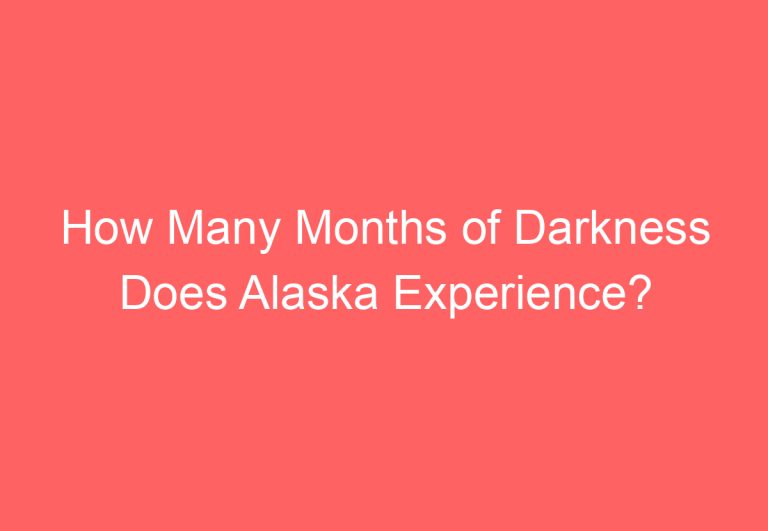Why Does Alaska Not Get Dark During Summer Months?
Alaska, the largest state in the United States, is known for its long and dark winters. However, there is a common misconception that Alaska experiences six months of total darkness. In reality, this is not entirely true. While certain parts of Alaska do experience periods of extended darkness, the state also experiences periods of extended daylight.

The reason for Alaska’s extended daylight and darkness is due to its location in the northern hemisphere. During the summer months, Alaska experiences long periods of daylight due to its proximity to the Arctic Circle. Conversely, during the winter months, Alaska experiences long periods of darkness due to its location further away from the equator. This is due to the Earth’s axial tilt, which causes the sun’s rays to hit different parts of the Earth at different angles throughout the year.
Despite this, there are some parts of Alaska that do experience long periods of darkness during the winter months. For example, the northernmost city in Alaska, Utqiaġvik (formerly known as Barrow), experiences near-constant darkness from mid to late November until late January. However, it’s important to note that not all parts of Alaska experience this level of darkness during the winter months.
Phenomenon of the Midnight Sun and Polar Night

The phenomenon of the Midnight Sun and Polar Night is one of the most fascinating natural occurrences on our planet. It is a result of the Earth’s axial tilt and the distribution of sunlight across its surface. In this section, we will explore how this phenomenon occurs and why Alaska experiences it.
Understanding Earth’s Axial Tilt and Sunlight Distribution
The Earth’s axial tilt is the reason why we have seasons. As the Earth orbits around the Sun, its axis remains tilted at an angle of approximately 23.5 degrees. This tilt causes different parts of the Earth to receive varying amounts of sunlight throughout the year.
During the summer solstice (around June 22), the Northern Hemisphere is tilted towards the Sun, resulting in longer daylight hours and shorter nights. Conversely, during the winter solstice (around December 21), the Northern Hemisphere is tilted away from the Sun, resulting in shorter daylight hours and longer nights.
Alaska’s Unique Position within the Arctic Circle
Alaska is located within the Arctic Circle, which is a region of high latitudes that experiences extreme variations in daylight hours throughout the year. During the summer solstice, Alaska experiences 24-hour daylight, while during the winter solstice, it experiences 24-hour darkness.
This is due to Alaska’s unique position within the Arctic Circle, where the Sun remains above the horizon for an extended period during the summer months and below the horizon for an extended period during the winter months.
The Cycle of Seasons and Daylight Variations
The cycle of seasons and daylight variations is a result of the Earth’s axial tilt and its orbit around the Sun. During the equinoxes (around March 20 and September 22), the Earth’s axis is not tilted towards or away from the Sun, resulting in equal amounts of daylight and darkness across the globe.
However, in high latitudes such as Alaska, the equinoxes do not have a significant impact on the amount of daylight hours. Instead, the Midnight Sun and Polar Night phenomena are more pronounced, resulting in 24-hour daylight or darkness for extended periods.
In conclusion, the Midnight Sun and Polar Night phenomena are a result of the Earth’s axial tilt and the distribution of sunlight across its surface. Alaska’s unique position within the Arctic Circle makes it a prime location to experience these phenomena. Understanding the cycle of seasons and daylight variations is crucial to understanding these natural occurrences.
Impacts on Life in Alaska

Alaska’s unique geography and position on the globe make it a place of extremes in terms of daylight and darkness. The extended periods of daylight and darkness have significant impacts on the lives of Alaskans, wildlife, environment, tourism, culture, and economy.
Adaptations of Alaskans to Extended Daylight and Darkness
Alaskans have adapted to the extremes of daylight and darkness in various ways. During the summer months, when the sun doesn’t set for 24 hours, Alaskans take advantage of the extra daylight to engage in outdoor activities such as hiking, fishing, and camping. Many buildings have blackout curtains to help people sleep during the extended daylight hours.
In winter, when the sun doesn’t rise for weeks at a time, Alaskans have learned to adapt to the darkness. They use artificial light to help with daily activities. Some people also use light therapy to combat seasonal affective disorder (SAD), a type of depression that occurs during the winter months.
Effects on Wildlife and Natural Environment
The extended periods of daylight and darkness also have significant impacts on wildlife and the natural environment. During the summer months, the extended daylight hours provide more time for plants to grow, which leads to a more abundant food supply for animals. However, during the winter months, the lack of sunlight can make it difficult for plants to grow, which can lead to a shortage of food for animals.
Tourism, Culture, and Economy During Extremes of Light
Alaska’s unique daylight and darkness patterns attract tourists from all over the world. During the summer months, tourists flock to Alaska to experience the Land of the Midnight Sun and to witness the Northern Lights. The extended daylight hours also provide more time for outdoor activities, which is a draw for tourists.
During the winter months, tourism slows down, but the Northern Lights still attract visitors. Many Alaskans also take advantage of the extended darkness to engage in indoor activities such as reading, relaxing, and spending time with family and friends.
The unique daylight and darkness patterns also have significant impacts on the economy. In places like Barrow and Utqiaġvik, where the sun doesn’t rise for weeks at a time, energy consumption is higher, and people need to use artificial light to go about their daily activities. In places like Fairbanks, where the sun doesn’t set for 24 hours during the summer months, the increased daylight hours provide more time for outdoor activities, which can lead to increased revenue for businesses that cater to tourists.
Overall, the impacts of Alaska’s unique daylight and darkness patterns are significant and affect many aspects of life in the state. Alaskans have learned to adapt to the extremes, and tourists come from all over the world to experience the Land of the Midnight Sun and witness the Northern Lights.
Frequently Asked Questions

How long does the period of extended daylight last in Alaska?
The period of extended daylight in Alaska lasts for several months, typically between late May and late July. During this time, the sun remains above the horizon for most of the day, resulting in nearly 24 hours of daylight in some regions of the state.
What causes the phenomenon of continuous daylight in Alaska during certain times of the year?
The phenomenon of continuous daylight in Alaska during certain times of the year is caused by the state’s location near the Arctic Circle. Due to the tilt of the Earth’s axis, the sun remains above the horizon for an extended period of time during the summer months in regions located north of the Arctic Circle.
During which months are Alaska’s daylight hours at their maximum?
Alaska’s daylight hours are at their maximum during the summer months of June and July. During this time, the sun remains above the horizon for most of the day, resulting in nearly 24 hours of daylight in some regions of the state.
Which regions of Alaska experience the most extreme daylight variations?
The regions of Alaska located north of the Arctic Circle experience the most extreme daylight variations. During the summer months, these regions experience nearly 24 hours of daylight, while during the winter months, they experience extended periods of darkness.
What is the duration of the ‘Midnight Sun’ in Alaska?
The duration of the ‘Midnight Sun’ in Alaska varies depending on the region. In the northernmost city of Barrow, the ‘Midnight Sun’ lasts for 82 days straight, while in other regions of the state, it may last for several weeks.
How does Alaska’s position on the globe affect its daylight and darkness cycles?
Alaska’s position on the globe near the Arctic Circle results in extended periods of daylight and darkness throughout the year. During the summer months, the state experiences nearly 24 hours of daylight, while during the winter months, it experiences extended periods of darkness. This is due to the tilt of the Earth’s axis, which causes the sun’s position in the sky to vary depending on the time of year and the location of the observer.






